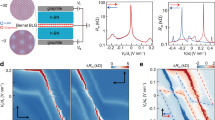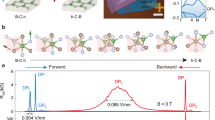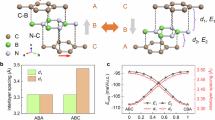Abstract
Interfacial ferroelectricity emerges in non-centrosymmetric heterostructures consisting of non-polar van der Waals (vdW) layers. Ferroelectricity with concomitant Coulomb screening can switch topological currents or superconductivity and simulate synaptic response. So far, it has only been realized in bilayer graphene moiré superlattices, posing stringent requirements to constituent materials and twist angles. Here we report ferroelectricity with concomitant Coulomb screening in different vdW heterostructures free of moiré interfaces containing monolayer graphene, boron nitride (BN) and transition metal chalcogenide layers. We observe a ferroelectric hysteretic response in a BN/monolayer graphene/BN, as well as in BN/WSe2/monolayer graphene/WSe2/BN heterostructure, but also when replacing the stacking fault-containing BN with multilayer twisted MoS2, a prototypical sliding ferroelectric. Our control experiments exclude alternative mechanisms, such that we conclude that ferroelectricity originates from stacking faults in the BN flakes. Hysteretic switching occurs when a conductive ferroelectric screens the gating field electrically and controls the monolayer graphene through its polarization field. Our results relax some of the material and design constraints for device applications based on sliding ferroelectricity and should enable memory device or the combination with diverse vdW materials with superconducting, topological or magnetic properties.
This is a preview of subscription content, access via your institution
Access options
Access Nature and 54 other Nature Portfolio journals
Get Nature+, our best-value online-access subscription
27,99 € / 30 days
cancel any time
Subscribe to this journal
Receive 12 print issues and online access
269,00 € per year
only 22,42 € per issue
Buy this article
- Purchase on SpringerLink
- Instant access to full article PDF
Prices may be subject to local taxes which are calculated during checkout




Similar content being viewed by others
Data availability
The data that support the findings of this study are available within the article and its Supplementary Information. Any other relevant data are available from the corresponding authors upon reasonable request.
References
Li, L. & Wu, M. Binary compound bilayer and multilayer with vertical polarizations: two-dimensional ferroelectrics, multiferroics, and nanogenerators. ACS Nano 11, 6382–6388 (2017).
Zhang, D., Schoenherr, P., Sharma, P. & Seidel, J. Ferroelectric order in van der Waals layered materials. Nat. Rev. Mater. 8, 25–40 (2023).
Wang, C., You, L., Cobden, D. & Wang, J. Towards two-dimensional van der Waals ferroelectrics. Nat. Mater. 22, 542–552 (2023).
Klein, D. R. et al. Electrical switching of a bistable moiré superconductor. Nat. Nanotechnol. 18, 331–335 (2023).
Jindal, A. et al. Coupled ferroelectricity and superconductivity in bilayer Td-MoTe2. Nature 613, 48–52 (2023).
Kang, K. et al. Switchable moiré potentials in ferroelectric WTe2/WSe2 superlattices. Nat. Nanotechnol. 18, 861–866 (2023).
Wu, Q., Kang, L., Wu, J. & Lin, Z. Large sliding regulation in van der Waals layered nonlinear optical ternary chalcogenides. npj Comput. Mater. 9, 1–10 (2023).
Fei, Z. et al. Ferroelectric switching of a two-dimensional metal. Nature 560, 336–339 (2018).
Vizner Stern, M. et al. Interfacial ferroelectricity by van der Waals sliding. Science 372, 1462–1466 (2021).
Yasuda, K., Wang, X., Watanabe, K., Taniguchi, T. & Jarillo-Herrero, P. Stacking-engineered ferroelectricity in bilayer boron nitride. Science 372, 1458–1462 (2021).
Woods, C. R. et al. Charge-polarized interfacial superlattices in marginally twisted hexagonal boron nitride. Nat. Commun. 12, 347 (2021).
Rogée, L. et al. Ferroelectricity in untwisted heterobilayers of transition metal dichalcogenides. Science 376, 973–978 (2022).
Weston, A. et al. Interfacial ferroelectricity in marginally twisted 2D semiconductors. Nat. Nanotechnol. 17, 390–395 (2022).
Wang, X. et al. Interfacial ferroelectricity in rhombohedral-stacked bilayer transition metal dichalcogenides. Nat. Nanotechnol. 17, 367–371 (2022).
Deb, S. et al. Cumulative polarization in conductive interfacial ferroelectrics. Nature 612, 465–469 (2022).
Ko, K. et al. Operando electron microscopy investigation of polar ___domain dynamics in twisted van der Waals homobilayers. Nat. Mater. 22, 992–998 (2023).
Zheng, Z. et al. Unconventional ferroelectricity in moiré heterostructures. Nature 588, 71–76 (2020).
Niu, R. et al. Giant ferroelectric polarization in a bilayer graphene heterostructure. Nat. Commun. 13, 6241 (2022).
Zheng, Z. et al. Electronic ratchet effect in a moiré system: signatures of excitonic ferroelectricity. Preprint at https://doi.org/10.48550/arXiv.2306.03922 (2023).
Yan, X. et al. Moiré synaptic transistor with room-temperature neuromorphic functionality. Nature 624, 551–556 (2023).
Wang, Y. et al. Ferroelectricity in hBN intercalated double-layer graphene. Front. Phys. 17, 43504 (2022).
Sharma, P. et al. A room-temperature ferroelectric semimetal. Sci. Adv. 5, eaax5080 (2019).
de la Barrera, S. C. et al. Direct measurement of ferroelectric polarization in a tunable semimetal. Nat. Commun. 12, 5298 (2021).
Van Winkle, M. et al. Engineering interfacial polarization switching in van der Waals multilayers. Nat. Nanotechnol. 19, 751–757 (2024).
Lv, M. et al. Spatially resolved polarization manipulation of ferroelectricity in twisted hBN. Adv. Mater. 34, 2203990 (2022).
Lv, M. et al. Multiresistance states in ferro- and antiferroelectric trilayer boron nitride. Nat. Commun. 15, 295 (2024).
Molino, L. et al. Ferroelectric switching at symmetry-broken interfaces by local control of dislocations networks. Adv. Mater. 35, 2207816 (2023).
Yang, T. H. et al. Ferroelectric transistors based on shear-transformation-mediated rhombohedral-stacked molybdenum disulfide. Nat. Electron. 7, 29–38 (2024).
Wang, Z.-J. et al. Conversion of chirality to twisting via sequential one-dimensional and two-dimensional growth of graphene spirals. Nat. Mater. 23, 331–338 (2024).
Zhao, Y. et al. Supertwisted spirals of layered materials enabled by growth on non-Euclidean surfaces. Science 370, 442–445 (2020).
Castellanos-Gomez, A. et al. Van der Waals heterostructures. Nat. Rev. Methods Prim. 2, 1–19 (2022).
Martin, J. W. et al. Graphite rapidly forms via annihilation of screw dislocations. Carbon 215, 118386 (2023).
Ci, P. et al. Breaking rotational symmetry in supertwisted WS2 spirals via moiré magnification of intrinsic heterostrain. Nano Lett. 22, 9027–9035 (2022).
Park, H. J. et al. Double-spiral hexagonal boron nitride and shear strained coalescence boundary. Nano Lett. 19, 4229–4236 (2019).
Liu, Y. et al. Helical van der Waals crystals with discretized Eshelby twist. Nature 570, 358–362 (2019).
Tay, R. Y. et al. Concentric and spiral few-layer graphene: growth driven by interfacial nucleation vs screw dislocation. Chem. Mater. 30, 6858–6866 (2018).
Shearer, M. J. et al. Complex and noncentrosymmetric stacking of layered metal dichalcogenide materials created by screw dislocations. J. Am. Chem. Soc. 139, 3496–3504 (2017).
Ly, T. H. et al. Vertically conductive MoS2 spiral pyramid. Adv. Mater. 28, 7723–7728 (2016).
Sarma, P. V., Patil, P. D., Barman, P. K., Kini, R. N. & Shaijumon, M. M. Controllable growth of few-layer spiral WS2. RSC Adv. 6, 376–382 (2015).
Zhang, L. et al. Three-dimensional spirals of atomic layered MoS2. Nano Lett. 14, 6418–6423 (2014).
Chen, L. et al. Screw-dislocation-driven growth of two-dimensional few-layer and pyramid-like WSe2 by sulfur-assisted chemical vapor deposition. ACS Nano 8, 11543–11551 (2014).
Park, H. J. et al. One-dimensional hexagonal boron nitride conducting channel. Sci. Adv. 6, eaay4958 (2020).
Zhao, T. et al. Substrate engineering for wafer-scale two-dimensional material growth: strategies, mechanisms, and perspectives. Chem. Soc. Rev. 52, 1650–1671 (2023).
Xu, X. et al. Growth of 2D materials at the wafer scale. Adv. Mater. 34, 2108258 (2022).
Zhang, L., Dong, J. & Ding, F. Strategies, status, and challenges in wafer scale single crystalline two-dimensional materials synthesis. Chem. Rev. 121, 6321–6372 (2021).
Wang, W. et al. Clean assembly of van der Waals heterostructures using silicon nitride membranes. Nat. Electron. 6, 981–990 (2023).
Li, H. et al. Constructing van der Waals heterostructures by dry-transfer assembly for novel optoelectronic device. Nanotechnology 33, 465601 (2022).
Frisenda, R. et al. Recent progress in the assembly of nanodevices and van der Waals heterostructures by deterministic placement of 2D materials. Chem. Soc. Rev. 47, 53–68 (2018).
Qi, J. et al. Stacking-controlled growth of rBN crystalline films with high nonlinear optical conversion efficiency up to 1%. Adv. Mater. 36, 2303122 (2024).
Kim, K. et al. Tunable moiré bands and strong correlations in small-twist-angle bilayer graphene. Proc. Natl Acad. Sci. USA 114, 3364–3369 (2017).
Wang, L. et al. One-dimensional electrical contact to a two-dimensional material. Science 342, 614–617 (2013).
Acknowledgements
This work was supported by the National Key R&D Program of China (grant numbers 2021YFA1400100 (J.L.) and 2019YFA0307800 (J.L., Z.V.H. and J.M.)), the NSF of China (grant numbers 12374168 (J.L.), 62275265 (C.H.), 12450003 (Z.V.H.), 92265203 (Z.V.H.), 52021001 (B.P.) and 12274090 (W.S.)), the Beijing Natural Science Foundation (grant number 4222084 (C.H.)) and the Natural Science Foundation of Shanghai (grant number 22ZR1406300 (W.S.)). Z.V.H. acknowledges the support of the Fund for Shanxi “1331 Project” Key Subjects Construction, and the support of the Innovation Program for Quantum Science and Technology (grant no. 2021ZD0302003). This research was also supported by the CAS Project for Young Scientists in Basic Research (YSBR-003 (W.Z.)). This research benefited from resources and supports from the Electron Microscopy Center at the University of Chinese Academy of Sciences (W.Z.). We also acknowledge the support from Peking Nanofab (J.L.).
Author information
Authors and Affiliations
Contributions
J.L., Z.V.H. and C.H. conceived the project. R.N., Z.L., X.H. and Z.Q. fabricated devices and performed transport measurements with assistance from Z.W. and C.H.; crystallographic characterization was performed by R.N., Z.L. and Q.L., assisted by K.L. and J.M.; TEM characterization of electrical transport devices and identification of microstructures in boron nitride were carried out by C.W., supervised by W.Z.; TEM characterization of capacitance devices was done by C.Y. and Y.W., supervised by R.C. and B.P.; AFM characterization was performed by M.L., supervised by J.X.; theoretical calculation was done by M.W.; K.W. and T.T. synthesized boron nitride crystals; J.L., Z.V.H., C.H. and Z.G. supervised the project. All authors contributed to the data analysis. R.N., Z.V.H., C.H. and J.L. wrote the paper with input from all authors.
Corresponding authors
Ethics declarations
Competing interests
The authors declare no competing interests.
Peer review
Peer review information
Nature Nanotechnology thanks the anonymous reviewers for their contribution to the peer review of this work.
Additional information
Publisher’s note Springer Nature remains neutral with regard to jurisdictional claims in published maps and institutional affiliations.
Supplementary information
Supplementary Information
Sections 1–12, including Supplementary Figs. 1–20, discussion and Table 1.
Rights and permissions
Springer Nature or its licensor (e.g. a society or other partner) holds exclusive rights to this article under a publishing agreement with the author(s) or other rightsholder(s); author self-archiving of the accepted manuscript version of this article is solely governed by the terms of such publishing agreement and applicable law.
About this article
Cite this article
Niu, R., Li, Z., Han, X. et al. Ferroelectricity with concomitant Coulomb screening in van der Waals heterostructures. Nat. Nanotechnol. 20, 346–352 (2025). https://doi.org/10.1038/s41565-024-01846-4
Received:
Accepted:
Published:
Issue Date:
DOI: https://doi.org/10.1038/s41565-024-01846-4
This article is cited by
-
The interplay of ferroelectricity and magneto-transport in non-magnetic moiré superlattices
Nature Communications (2025)



